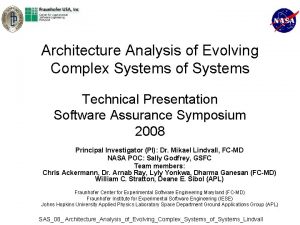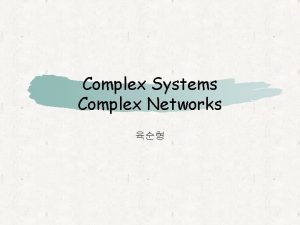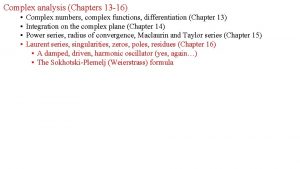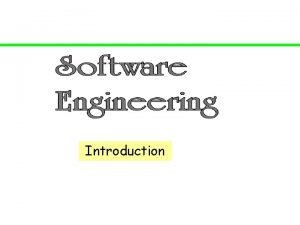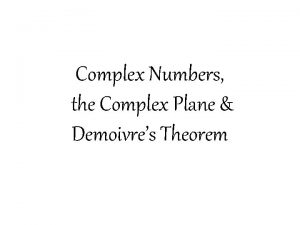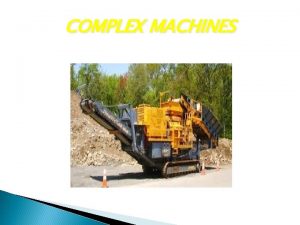Architecture Analysis of Evolving Complex Systems of Systems











- Slides: 11

Architecture Analysis of Evolving Complex Systems of Systems Executive Status Report Software Assurance Symposium 2008 Principal Investigator (PI): Dr. Mikael Lindvall, FC-MD NASA POC: Sally Godfrey, GSFC Team members: Chris Ackermann, Dr. Arnab Ray, Lyly Yonkwa, Dharma Ganesan (FC-MD) William C. Stratton, Deane E. Sibol (APL) Fraunhofer Center for Experimental Software Engineering Maryland (FC-MD) Fraunhofer Institute for Experimental Software Engineering (IESE) Johns Hopkins University Applied Physics Laboratory Space Department Ground Applications Group (APL) SAS_08_ Architecture_Analysis_of_Evolving_Complex_Systems_of_Systems_Lindvall

Problem/Approach • Systems are often difficult to understand – Systems of systems adds to the challenge – Makes system verification difficult – Interfaces often source of problems • Approach – Architecture analysis focusing on interfaces • The new tool, Dynamic SAVE, – extends the already existing static Software Architecture Visualization and Evaluation (SAVE) tool SAS_08_ Architecture_Analysis_of_Evolving_Complex_Systems_of_Systems_Lindvall

Dyn-SAVE Vision Compare Planned and Actual Telemetry Form Actual Behavior Client Behavior Specify Planned Behavior Capture Dynamic Information Specify Level of Abstraction For analysis Telemetry Server • • • Who does socket communicate with? Is communication according to specification? Check Sequences, Parameters, Values, Timing SAS_08_ Architecture_Analysis_of_Evolving_Complex_Systems_of_Systems_Lindvall

Relevance to NASA – NASA systems often developed by different teams – Interface Control Documents (ICD) is key, but • ICDs often interpreted differently because • ICDs implicit, lack important details etc. – Cause subtle critical deviations from specified behavior • Deviations difficult to detect • Emerging behavior difficult to predict – Can result in severe problems, e. g. lost data, performance – Need to • Detect deviations before deployment • (Specify expected and actual behavior before creating ICD!) SAS_08_ Architecture_Analysis_of_Evolving_Complex_Systems_of_Systems_Lindvall

Dyn. SAVE in perspective These systems are based on ICDs (Interface Control Documents) APL’s Common Ground System 5 SAS_08_ Architecture_Analysis_of_Evolving_Complex_Systems_of_Systems_Lindvall

Current capabilities • Applied to APL’s Telemetry protocol – See example below • Currently Capabilities allows us to – Model planned behavior (based on ICD) • Sequences, Parameters, Values, Timing – Capture and parse actual communication – Visualize actual behavior – Compare planned behavior to actual – Automatically detect and visualize deviations • Already detected some surprising deviations! SAS_08_ Architecture_Analysis_of_Evolving_Complex_Systems_of_Systems_Lindvall

Abstract planned diagram for Telemetry protocol The “simplest” diagram that describes the planned communication behavior described in the ICD. Enhance in iterative fashion. SAS_08_ Architecture_Analysis_of_Evolving_Complex_Systems_of_Systems_Lindvall

Detailed planned & actual =STF) Illegal Filter Specification STF ordered – STP received More examples and details in technical presentation! SAS_08_ Architecture_Analysis_of_Evolving_Complex_Systems_of_Systems_Lindvall

Planned capabilities Being able to • Model Planned behavior of – Ground system software – Flight software – Communication between Ground and Flight • e. g. CFDP • Visualize actual behavior • Compare planned and Actual behavior • Automatically detect and visualize deviations SAS_08_ Architecture_Analysis_of_Evolving_Complex_Systems_of_Systems_Lindvall

Technical challenges • Difficult to use existing case tools to create planned sequence diagrams, e. g. – Most only support basic diagrams – Export formats often are not correct, usable • Overcoming the problem – Provide importers for case tool – Provide our own sequence diagram editors SAS_08_ Architecture_Analysis_of_Evolving_Complex_Systems_of_Systems_Lindvall

Summary • Analyze, Visualize, and Evaluate – structure and behavior using – static and dynamic information – individual systems as well as systems of systems • Next steps: – Refine software tool support – Apply to other systems – Apply earlier in system life cycle SAS_08_ Architecture_Analysis_of_Evolving_Complex_Systems_of_Systems_Lindvall












